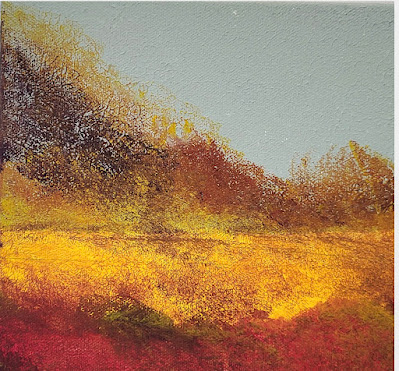Barbara Kennison - Phi Chapter - Michigan
Dr. Kennison is a retired psychiatric certified clinical nurse specialist. Barbara’s teaching experience began in 1973 as an assistant professor of psychiatric mental health nursing, at Nazareth College, Nazareth, Michigan. She worked as a teaching assistant at the School of Nursing at the University of Michigan and was an assistant professor of psychiatric community health nursing at Loyola University of Chicago, Illinois. She worked with undergraduate and graduate students. In 1988, she began private practice. Barbara worked with children, adults, and graduate students. She utilized art with traumatized children who had difficulty expressing their fears and concerns.
Barbara loves nature, music, and the performing arts. She uses acrylics or watercolors in nature scenes. When using acrylics, she applies paint to canvas versus board or paper. After creating a mock-up of work using watercolors, she uses cold-pressed watercolor paper. It allows her to use watercolors, ink, and acrylic and dries quickly. The paper allows for creating textures and absorbs paint more easily which enables the artist to achieve a softer quality versus a hard or defined attribute to the work. This paper is expensive so one must be careful in how it is used.
Tell us about “My Sunny Day.” Where did the inspiration come from?
The inspiration for “My Sunny Day”, came from observations of a meadow beyond the backyard of Barbara’s home. It was a sunny afternoon with a clear sky and moderate winds. She made a sketch on a piece of scrap paper, took it to her studio, and painted what she thought she saw. The scene evoked memories of Andrew Wyeth’s work in what seemed to her, to convey a sense of simplicity in its detail and subtle use of color that were muted and transparent. She views him as a master of light and subtle shading. His application of paint to achieve earth tones and movement is outstanding. One thing that she feels her work may have in common with Wyeth’s work is the emotion evoked by the composition. She said, “I think that is why I laughed to myself, once my work was finished and remarked, “Andrew Wyeth, this is, “My Sunny Day.” Unlike Wyeth, my medium is acrylic which allowed me to achieve the effect I wanted.”
In “The Wolf Moon”, what inspired the title? “The Wolf Moon,” is a collage oncanvas. It was inspired by observations of the mid-January full moon, shimmering through the trees onto the crystal-cold snow covering the ground. Barbara could see the view from the kitchen window. It was a special moment to witness this phenomenon in the stillness of the night while others were sleeping. In some Native traditions, the title, “Wolf Moon” was derived from hearing wolves howling beyond their villages during the January full moon. Wolves are pack animals and howling may be a signal for such activities as calling a mate, alerting there is danger, or signaling a need to gather for a hunt. It may be a myth, but Barbara felt it was a good topic to convey in her art. The juxtaposition of the cut paper on canvas achieves the result of the bright slivery moon casting its shadow among the clouds. The title for this work was fitting, given the time of year the moon was visible to her.
What advice would you offer someone interested in learning about painting and mixed media artwork?
Barbara responded, “I think sketching is vital, as it permits the person to look closely at the object being sketched, noting structure in all its detail.” Sketching helps to develop a sense of proportion, perspective, light, and shadow. For adults, she recommends they consider art as a way of relaxing and discovering what one likes or dislikes, and then understanding why. Kennison suggested taking art classes to learn the basics of each type of media and equipment. Reading books about art and artists, and visiting local art shows and art centers are all other ways to learn more about art.
How does the value of the arts, impact education?
Barbara thinks that all art forms have a tremendous impact on education. Participation in the visual arts, all have a positive influence on academic life and relationships. Research has demonstrated the impact art has on academic performance. Art allows for the exploration of emotions, encourages empathy, and makes a significant contribution to culture.
Are there other things you wish to share about yourself or your DKG journey? Barbara explained, “Responding to the questions posed has evoked memories, special and happy memories as well as painful ones. This has been a good exercise for me, and I am grateful to you, Linda for posing the questions. In closing, I treasure my connections with the DKG organization. The support from this organization has been tremendous. I am awed by DKG members’ commitment, dedication, and action to promote and support its members, educators, and students locally, statewide, and nationally.






.jpeg)
Barbara, I find your work intriguing. Are your color choices solely based on what you see, or are they also influenced by what you are feeling when making a work?....Jackie Thomas, Omicron Chapter, Pennsylvania
ReplyDeleteCongratulations, Barbara! I love your paintings. You see the world in your own way. I feel an emotional charge in your works. They are very personal, as if they were pages from your diary.
ReplyDeleteElena Ivanova, Beta Chi, Michigan
Barbara, your painting is magic turned into color lines. I really like it. Hilda Díaz de Cano, DKG jalisco State, Mexico
ReplyDelete